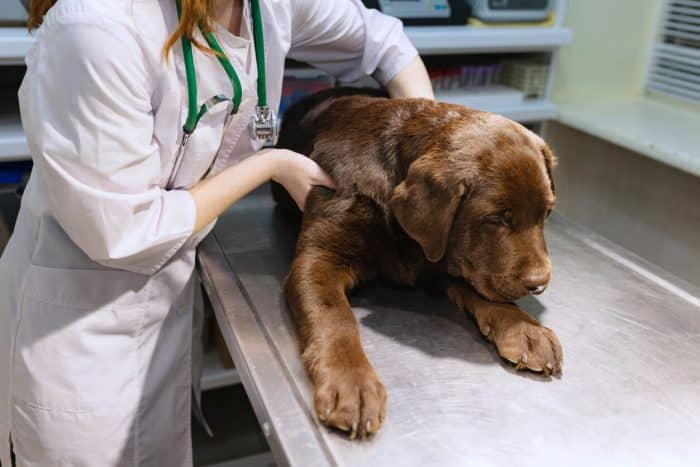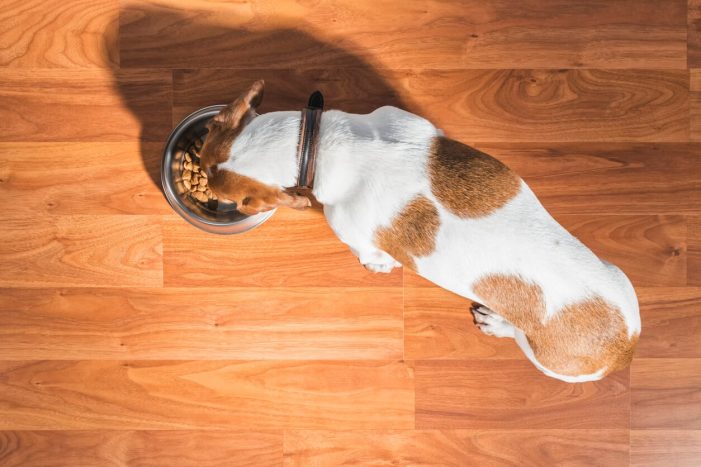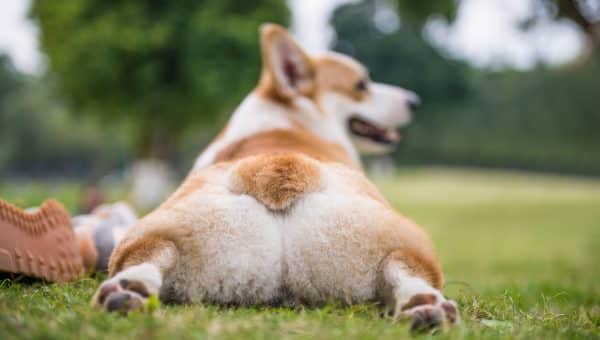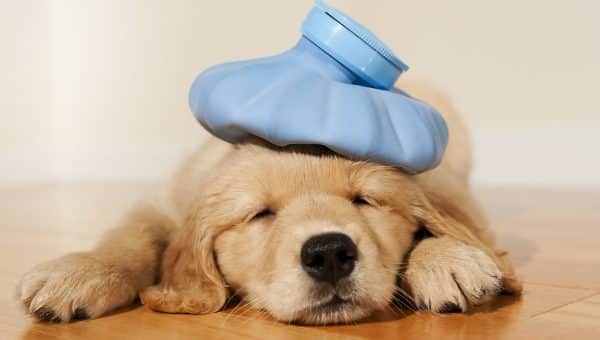- Not a substitute for professional veterinary help.
Your dog’s weight plays a pretty important role in their overall well-being, which is why it’s important to learn how to tell if your dog is overweight, underweight, or just right. Not sure you can get your dog on a scale? That’s OK—you can use the body condition score (BCS) to help track your dog’s weight.
Obesity can contribute to skin infections, grooming issues, impaired mobility, and and increased risk of serious health problems like heart disease and diabetes, according to Andrea Johnston, a board-certified small animal veterinary internist and medical board member at The Vets. Being underweight, on the other hand, can affect your dog’s skin and coat, energy, bone health, and growth and development.
The BCS is one important way to check a dog’s fitness, Dr. Johnston says. “Regular checks by veterinarians and pet parents catch weight gain early, allowing for timely adjustments in nutrition and exercise plans. Monitoring the score ensures dogs stay vigorous and enjoy a healthy life.”
Read on to learn more about the BCS for dogs and how to check your dog’s body condition at home, plus get some tips on supporting a healthy weight for your dog.
How Does The Body Condition Score for Dogs Work?
The BCS, designed by the World Small Animal Veterinary Association (WSAVA), is a universal method widely used by vets to evaluate a dog’s body fat condition and check for overweight or obesity.
Vets consider a dog overweight if they weigh more than 15% above their ideal body weight and obese when their weight exceeds 30% of their ideal body weight. The scale can also check palpability, or how easily fat can be felt under the skin. This helps predict a dog’s BCS based on the amount of fat felt.
There are two body condition scoring systems vets use for both dogs and cats—a 5-point scale and a 9-point scale. Dr. Johnston shares some reasons why a vet may use one or the other.
- Simplicity: Some vets may prefer a 5-point scale to simplify the three primary categories (i.e. thin, ideal, and overweight) and help pet parents set weight goals for their pet.
- Breed/age factors: Scales developed for a specific breed may better account for variations, like typically slender sighthounds. Vets can also use a specialized scale for growing puppies.
- Consistency: In a large vet hospital, the simpler 5-point scale can allow staff with different levels of experience to interpret results more easily.
- Customization: Adjusted scales can help characterize unique traits in certain groups of dogs. For instance, vets who often treat working dogs may check for different cues than vets who typically work with show dogs or pets.
Some vets may also design their own qualitative charts for scoring a dog’s appearance, ribs, and other traits based on years of experience with averages in the animals they treat.
Under ideal
Dogs with an under ideal BCS will fall between 1-3 on a 9-point scale and between 1-2 on a 5-point scale. They’ll often show these signs:
- Visible bones
- Little to no palpable fat
- Minimal to obvious loss of muscle mass
Ideal
Dogs with an optimal body weight will fall between 4-5 on a 9-point scale and 3 on a 5-point scale. This score is considered ideal for most dogs, Dr. Johnston says. She adds that since working dogs are often leaner, they tend to score between 4 and 4.5.
Dogs with an ideal BCS:
- Have a visible waist when viewed from above
- Have some palpable fat on their ribs
- Show a tucked-up abdomen
Over ideal
Dogs with an over ideal BCS will fall between 6-9 on a 9-point scale. On a 5-point scale, they’ll fall between 4-5.
Dogs with an over ideal BCS:
- Have noticeable fat deposits on their body
- Have heavy fat cover that’s only palpable with significant pressure
- Have a barely visible or absent waist
The Pros And Cons Of A Body Condition Score
Vets use body condition scores as a consistent way to assess a dog’s weight and health risks, Dr. Johnston says.
Annual exams and sick visits with a standardized BCS chart help catch weight issues early, which makes it easier to develop diet and exercise plans. Monitoring a dog’s BCS can track their progress with weight loss and provide a baseline for detecting underlying conditions, she adds.
That said, the scale does have a few limitations. For instance:
- Growing puppies need customized charts.
- Visual scoring may prove challenging for certain breeds.
- Conditions, like fluid retention, can lead to inaccurate results.
- Severe arthritis can affect mobility assessments.
- Validation of the scale is ongoing for new breeds.
Despite these limitations, the scale is still an important tool. Your vet may also use other health measures in complex cases.
Dr. Johnston breaks down the pros and cons of a body condition score below:
| Pros | Cons |
| Can help when a dog is difficult to keep still or weigh | Could be open to subjectivity. Pet parents, techs, and vets may all get different scores |
| Provides an objective way to check body fat coverage levels across breeds | May not be helpful when used alone without considering other health factors |
| Can easily track a dog’s weight gain and weight loss over time | Does not differentiate between lean muscle and fat mass. May need breed-specific validation and adjustment. |
| Visual and palpable criteria account for both appearance and feel | Less accurate in animals with heavy coats and animals who don’t align with breed standards |
| Quick, easy, and inexpensive to use in clinic setting or home | Requires skill and training to use properly |
| Can lead to actionable guidance for nutrition, exercise, and weight management | Miscalculating the ideal condition range for an animal could lead to the wrong health goals |
How To Take A Body Condition Score At Home
You can check your dog’s body condition at home, and you don’t need any special equipment. It’s a hands-on process where you’ll feel your dog’s ribs, waist, and other body areas, says Dr. Sabrina Kong, DVM, a veterinary consultant at We Love Doodles.
She recommends checking on a monthly basis and using this score alongside regular checkups from your vet. It helps if your dog sits still, but they don’t need to remain incredibly still during this process. If you’ve got a pup that’s a little wiggly, that’s OK!
Dr. Kong shares some tips on using this scale at home:
- Feel the ribs: They should be easily palpable but not too prominent.
- Observe the waist from above: Your dog should have a visible waistline
- Look at the dog’s profile: The abdomen should be tucked up, not sagging.
If your dog has suddenly lost or gained some weight, you’ll want to get advice from a vet or nutritionist right away. Unexpected weight gain can often point to health concerns, which may become serious without treatment.
What about super fluffy dogs?
Getting an accurate BCS for a fluffy breed, like a Poodle, can be challenging if you only check them visually—their hair can add to the score. On the other hand, naturally slender breeds, like Italian Greyhounds, may score low even when perfectly healthy.
For fluffy or uniquely built dogs, Dr. Kong recommends relying more on palpation than visuals. “Feel for the ribs and assess the body fat,” she says. “Different breeds will have different ideal BCS, so consider breed-specific characteristics.”
Some may consider this a flaw with the BCS. However, Dr. Kong says it’s simply an aspect that requires some adjustment to use the tool properly.
Worried about your dog’s score?
If your dog has an over or under ideal BCS, schedule a vet visit for further evaluation and guidance on what to do next. This score is a great way to get a general idea of your dog’s health in terms of weight, but it’s just one of many tools your vet can use to check their overall health.
Your vet can also offer more guidance if your dog has a normal BCS but struggles to eat certain foods or has trouble with digestion.
How To Manage A Dog’s Weight
Dr. Kong says a BCS can help guide your dog’s weight management journey by providing insight on whether you need to adjust their diet and exercise to help them gain or lose weight to reach their body condition ideal.
If your vet recommends your dog lose some weight, you have plenty of options to help them get more exercise and slow down their eating, including:
- Dog treadmills
- Automatic ball launchers
- Agility equipment
- Slow feeder bowls
- Puzzle toys
- Snuffle mats
Important: It’s always best to talk to your vet before changing your dog’s diet or exercise routine.
How to support your dog’s weight loss
If your dog is overweight, these steps can help them lose weight safely:
- Ask your vet about switching them to a low-fat dog food.
- Portion their meals.
- Limit treats or switch to low-calorie treat options.
- Make sure they’re drinking enough water.
- Increase their activity with more exercise and playtime.
How to help your dog put on weight
If your dog is underweight, these steps can help them put on weight safely:
- Feed them a high-quality, high-protein dog food.
- Offer multiple small meals each day instead of two large meals.
- Add a food topper to their kibble for extra calories.
- Treat them to high-calorie or high-protein snacks.
- Make sure they get the right amount of exercise for their size and breed.
Health Risks Of An Under Or Over Ideal BCS
An estimated 46% of dogs are at an ideal weight, while 42% are considered overweight or obese and 12% underweight.
Dr. Kong says health risks of being underweight or overweight can develop quickly.
A score over 6 can raise a dog’s risk of health concerns, including:
- Joint problems
- High blood pressure
- Inflammation
- Pancreatitis
- Diabetes
- Kidney disease
- Heart disease
- Respiratory disease
- Cancer
The risks of underweight in dogs
The main risks associated with an under ideal BCS, according to Dr. Kong, include:
- Reduced muscle mass
- Weakened immune system
- Potential for organ damage
Why Do Dogs Become Overweight or Underweight?
Knowing exactly how much to feed your dog can be tricky. And even when you do portion out their food in the right amounts, many other factors can play a part in weight loss or gain, including:
- Spaying and neutering
- Breed and gender
- Indoor lifestyle
- Middle age
- Behavioral factors
- Dietary factors
- Stress
- Illness
When combined with regular vet checkups, the BCS can be a useful tool to help your dog achieve their optimal weight—which can help them stay happy and healthy for years to come!







